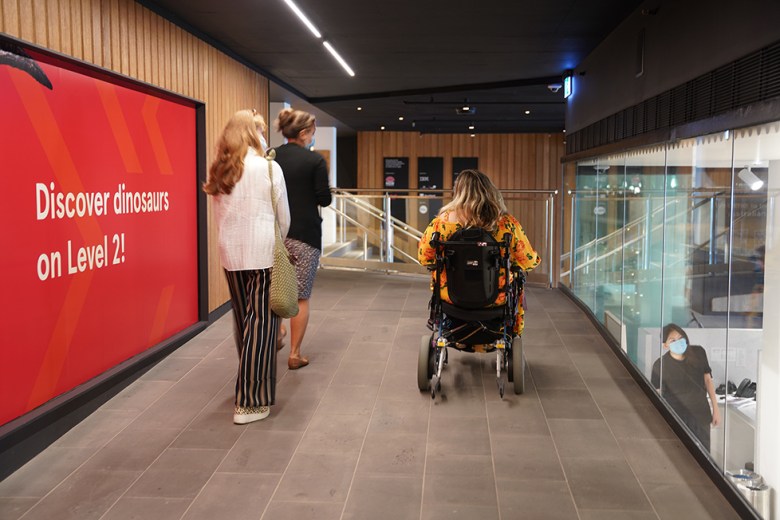“I had the privilege of visiting the Australian Museum (AM) with accessibility manager Zehra Ahmed and communications advisor, Claire Vince, who gave me a tour of the museum and their favourite exhibits. This is one of the most accommodating and accessible museums I have been to that appears to have thought of everything and is entirely carbon neutral! It is one of the first museums in Australia to have a committee of people with varying disabilities touring the site identifying areas that need work and finding solutions. The committee is ongoing and still making minor changes to the museum and as Zehra said, “the committee know that disability requirements are ever-changing”.
When the museum applied for a grant to do the renovations there were three things that needed fixing: the ceilings weren’t high enough for some of the new exhibits, floors were not able to take the weight of new exhibits, and accessibility needed updating. Part of the reason access was so important was because the museum is displaying exhibits from other countries, so it was necessary to meet both Australian and international accessibility standards.
One of the first and biggest changes the museum made was to the main entrance, which has been relocated to another side of the building making it accessible for all visitors. Previously there were stairs, so if you could not do stairs for any reason, you had to go around the block to an accessible entrance and work your way back to the main entrance from the inside. This change might not seem like such a big deal, but it is huge improvement for the disability community.
Halfway through my visit I stopped in the cafe for a coffee and was pleased to see at least four other wheelchair users in the museum, surely a testament to how good its accessibility is. In most places I visit seeing other wheelchairs is rare, so it is reassuring to find people like me enjoying the museum.
Another improvement was in the museum map. On each floor there is a large wooden wall map to help visitors find their way around the museum, with sensory markings from high/ medium/low for all spaces. A room could be categorised as high sensory with loud music, sound effects or flashing lights. It lets people know what to expect, avoiding a family from a possible melt down!
What really impressed me was the accessible bathroom, that was spacious enough for me to enter in my power wheelchair and not be concerned about reversing out or getting stuck. It has user-friendly electric door entry and inside an adult changing table I saw for the first time. This fully electric table folds out from the wall, using power to raise or lower to the users desired height. The table is so important and revolutionary because it says to adults with disabilities that we are welcome and worth taking care of. Most places have no changing table for adults only a children’s changing table, that leaves adults or larger children having to get changed on the floor or risk using a table that is not designed to take their size or weight.
There is a shower with a curtain for private wash and an electric ceiling hoist to assist with transferring from a mobility device to the toilet and shower. This gives the user more independence and avoids having be carried in when they need to go to the bathroom. I know many people who can only go out for a full day if their father can join them because their mother isn’t able to lift them.
The toilet features a retractable wall screen for privacy and the toilet paper has adjustable arms for easy reach. The shield is a good idea because often someone might need help getting into the bathroom and onto the toilet but not need help using the toilet and prefer to have that privacy. It is about giving people with disability independence and dignity. The mirror and sink are placed low and accessible for someone in a wheelchair. Every part of this bathroom made me feel comfortable and understood. The museum also has other accessible stalls available for visitors with disability who might not need as much aid as this bathroom provides. There is also a new parents’ room which I did not visit.
Overall, this was one of the nicest and least stressful trips to a museum I have had. I was able to spend time learning about our country and its history because it was made accessible to me in my power wheelchair. Wheelchairs are available on request and there is free entry for carers. There are hearing loops and portable hearing loops available in all the new spaces as well as in the rooftop restaurant. When I first arrived and was speaking to Zehra and Claire about the building I said how great it was that they were able to make changes to such an established building. Zehra said something that I am reminded of all too often: “Heritage can’t trump access”. This is something that is so true and yet I find myself making excuses for inaccessible places explaining the building is old, well known and loved. But access to everyone equally has to be more important.
For more information visit: www.australianmuseum.com.au

